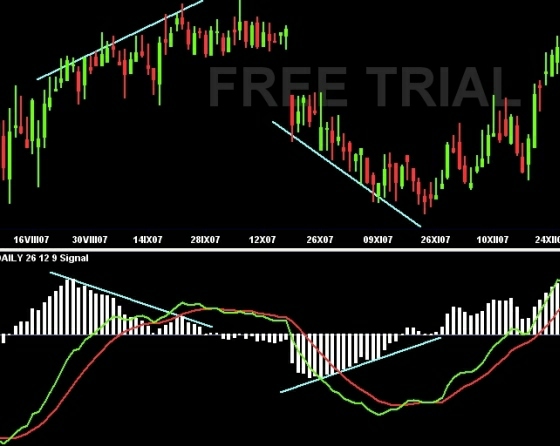MACD was created by Gerald Appel. MACD belongs to the Momentum Oscillators, that indicate the dynamics and strength of the current trend and oscillates around the zero line in both directions. MACD is an abbreviation for Moving Average Covergence Divergence. As the title says, it is all about approaching and retreating of moving averages (convergences and divergences).
MACD consists of three moving averages. Their usual settings are to 9, 12 and 26 time periods. The periods mentioned are just recommended but every trader can set the MACD according to his own preferences.
The construction of MACD is quite easy despite hard enough to explain. The calculation is as follows:
- MA12 – MA26 (subtract the 26-day EMA from the 12-day EMA). So we get quite new values called just MACD.
- Calculate the MA9 (9-days moving average) of the MACD values. This moving average is called a Trigger line.
- In 1986 Thomas Aspray introduced so called MACD histogram in addition. MACD – Trigger line = MACD Histogram. MACD Histogram is the result of subtracting the Trigger line from the MACD values. Histogram is just a graphic expression of the relations between MACD and its Trigger line. Should the MACD be higher than Trigger line, MACD Histogram is positive. Should it be lower, the Histogram would be negative. When MACD gets the same values as its Trigger line, the Histogram equals to zero.
The process described above is the complete calculation. According to the information sources or analytic tools you get to, you can find the process of MACD calculation without the final step (MACD histogram) or the MACD can be displayed as the difference EMA12 - EMA26.
As you can see on the picture bellow, the MACD values are displayed in the form of Histogram. (This histogram just displays the difference EMA12 – EMA26).

Copyright © Picture made by Incredible Charts
Description of the picture: MACD is based on two moving averages EMA12 and EMA26. EMA12 is the green curve and EMA26 is the red one. When these averages meet, the histogram crosses the zero line upwards or downwards. In other words, this histogram just pictures the difference between both moving averages. There is no Trigger line displayed.
You can see MACD values again, in the picture bellow. This time it is also with its trigger line, which is just an 5-days Moving average.

Copyright © Picture made by Incredible Charts
The blue horizontal lines mark moments when MACD values crossed its Trigger line.
How to use the MACD:
There is many ways how to use the Moving Average Convergences and Divergences. Besides traders use to adapt it in many ways to comply with their trading systems. Here are 4 basic ways of using it:
- The positive and negative divergences are a topic for a whole article. Positive divergences are made if the price graph formed lower low, but MACD refuses to sink lower. It formed Higher Low instead. It means that the bears aren't so strong now and a trend reversal can be expected very soon. Some nice divergences - positive and negative as well, are pictured in the image above. Take notice of the moment when the price graph reached Higher High, but the MACD formed just Lower High. It forecasted the trend reversal and a price decrease. You can also see the price graph forming Lower Low later, but MACD made just Higher Low. That predicted a trend reversal and Uptrend comming.
- MACD crossings. There is more ways of using it. E.g. some traders take into consideration every MACD/Trigger line crossing. If MACD crosses its Trigger line upwards, traders Buy. If it crosses downwards, they Sell. As such crossings are quite usual, some traders use a time filter - e.g. 3 days. If MACD crosses the Trigger line and remains in the zone for at least 3 days, they trade, should it crossed back within the time period, they avoided a loss trade. Other traders take into consideration just MACD/Trigger line crossings done above or bellow the zero line. If the MACD crossed its Trigger line upwards (in the zone bellow the Zero line), they go Long. If it crossed Trigger line downwards (above the Zero line), they go Short.
- MACD/Zero line crossings. The crossing means that the shorter Moving Average crossed the longer Moving Average - either Up or Down. I don't consider this being any special MACD signal. It is more like two moving averages trading system, not any special feature of MACD indicator.
- MACD Histogram evaluating (I mean MACD Histogram from the third step of construction). If the Histogram rises it means the market momentum gets stronger and the difference between MACD and its Trigger line extends. If the Histogram decreases, it means the momentum gets weaker and weaker so we can make use of it and predict Price reversals in advance.
In the end: If the trader wants the MACD become more fllexible, he must choose shorter time periods for EMA construction e.g. 5-10-18. So he can get sooner signals to buy or sell, but there will be more of them appearing. It means more false signals, as well. It is appropriate to consider what kind ot market do we want to trade and select the MACD settings according to the market nature and historical tests.
MACD is used to determine the long-term trend, too. If we want to do so, we can apply the MACD to weekly or monthly data. So we can get an idea about the long-term market direction and take trades just in line with it.
If you are interested in a deeper study of this technical indicator and prefer ready to serve solutions, this section may be of interest to you. There you can find all the available indicators in Excel file for download.
